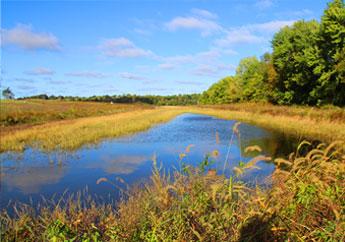Wetlands are transition areas between dry land and open waters; however, they are not always wet. Marshes, swamps and bogs are all considered wetlands. Wetlands are not considered freshwater ecosystems as there are some, such as salt marshes, that have high salt concentrations. Missouri has eight types of natural wetlands: swamps, shrub swamps, forested wetlands, marshes, wet meadows, fens and seeps, pond and lake borders and stream banks.
Usually wetlands contain plant-life adapted to survive in water-saturated soils, normally without oxygen (anaerobic). Plant species adapted to the very moist and humid conditions include pond lilies, cattails, sedges, tamarack and black spruce. Other plants found in wetlands include duckweed, water lilies, cattails, pondweed, reeds and bulrushes. Marsh flora include cypress and gum.
Wetlands have the highest species diversity of all ecosystems. Many species of amphibians, reptiles, birds (such as ducks and waders) and furbearers can be found in the wetlands. Wetlands with high salt concentrations can support different species of animals, such as shrimp and shellfish.

The Value of Wetlands
Every piece of wetlands provides value through social and environmental benefits (such as flood control, water quality improvements and wildlife habitat) in addition to the property’s economic value. The property’s market value is recognized by the owner. The social benefits are recognized by the public as well as the private owner.
Wetlands can provide habitat for fish and wildlife and recreation areas for people to hunt, fish and enjoy watching nature. Wetlands store floodwaters and maintain surface water flow during dry periods. Wetlands protect and improve water quality.
Restoring vs. Preserving Wetlands
Wetlands are impacted during construction of highways, roads, businesses and homes. The Federal Water Pollution Control Act, Title IV Permits and Licenses, Section 401 and Section 404 empower the state and federal government to regulate permit applicants that may discharge, dredge or place fill material into navigable waters and adjacent wetlands. Within the permit process, the federal government or the state may require compensation, replacement or restoration to mitigate wetland impacts. In theory wetland restoration may help to ensure that there is no net loss of wetlands. However, a restored wetland is never exactly the same as the drained or filled wetland. First, soil and water conditions will vary between wetlands and restored wetland functions may take many years before they can mimic a natural wetland. With different soil and water conditions, the mix of plants and animals also varies. In addition, the public may have accessibility to one wetland but not the other. Consequently, the functions and values of a restored wetland may vary from the drained or filled wetland.
Related Links:
- 401 Water Quality Certification
- Association of State Wetland Managers – Protecting the Nation's Wetlands
- EPA Office of Wetlands, Oceans and Watersheds
- EPA National Wetland Condition Assessment
- Wetlands Water Quality Standards Development
- The Power of People Connecting to Nature: Pathways to Wetland Conservation - Missouri Department of Conservation
- Missouri Wetland Program Plan
- U.S. Army Corps of Engineers
- U.S. Fish and Wildlife, National Wetland Inventory
- U.S. Geological Survey – National Wetland Research Center
- Wetlands Journal – Society of Wetland Scientists
- Missouri Geological Survey Publications
